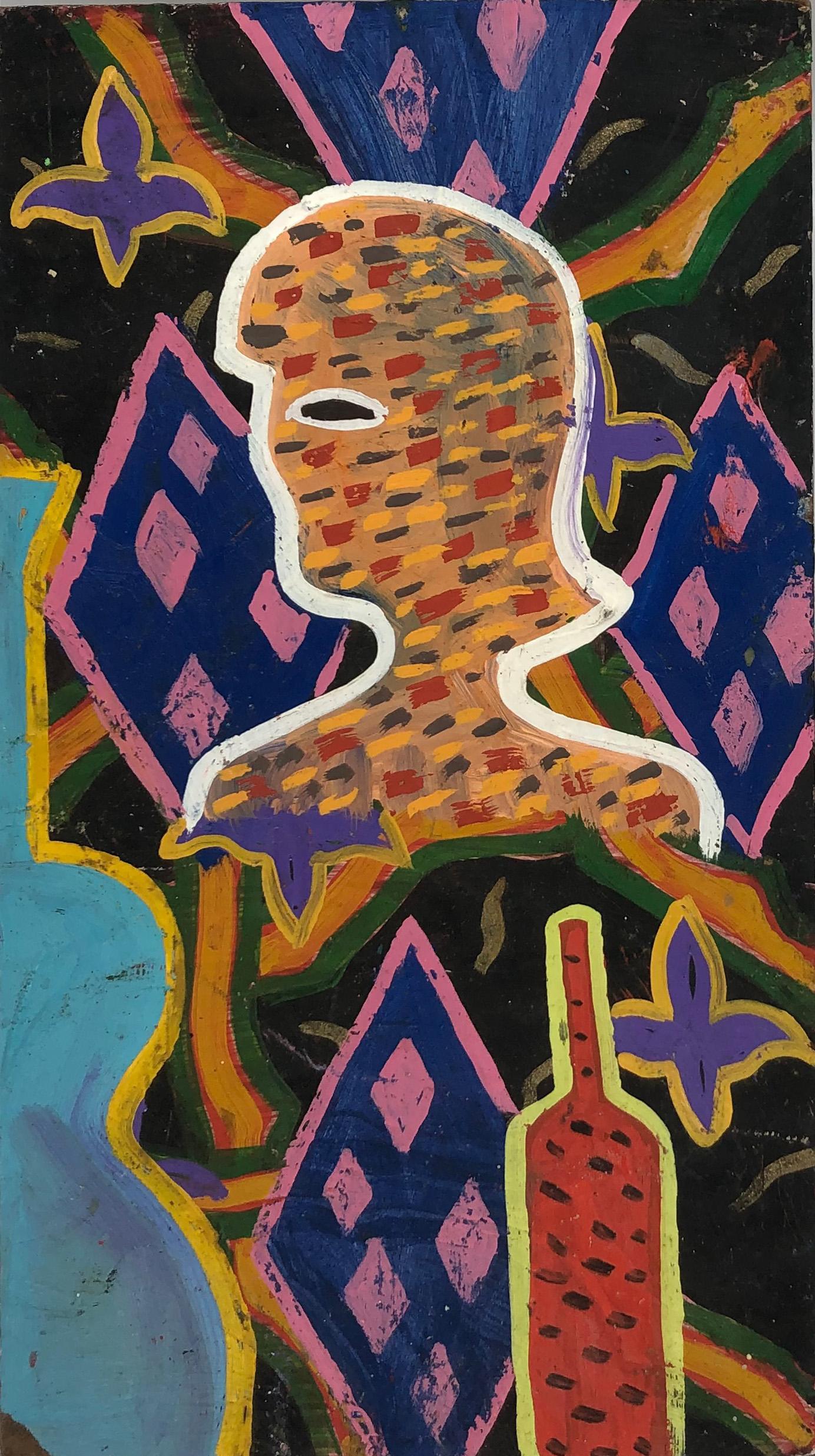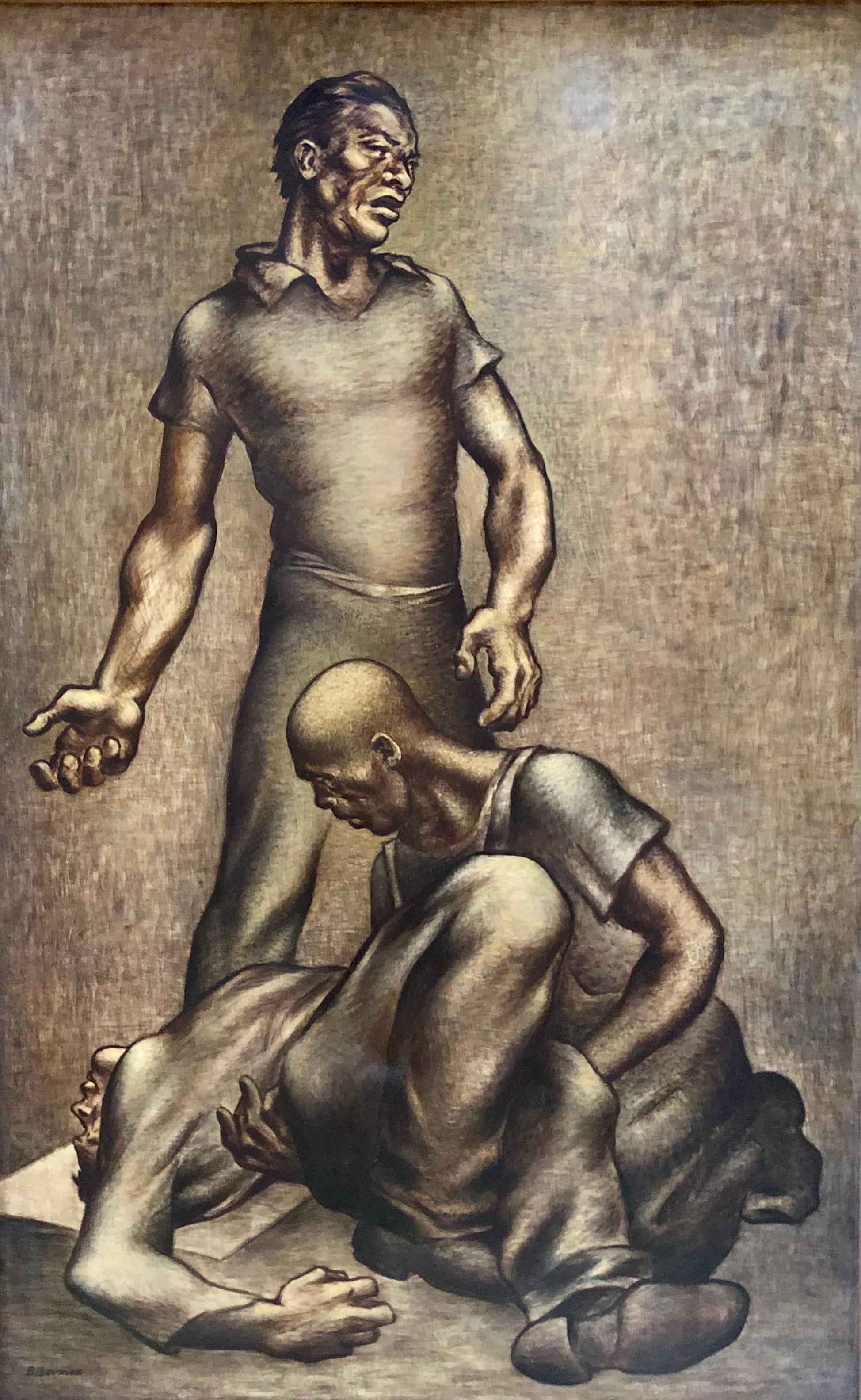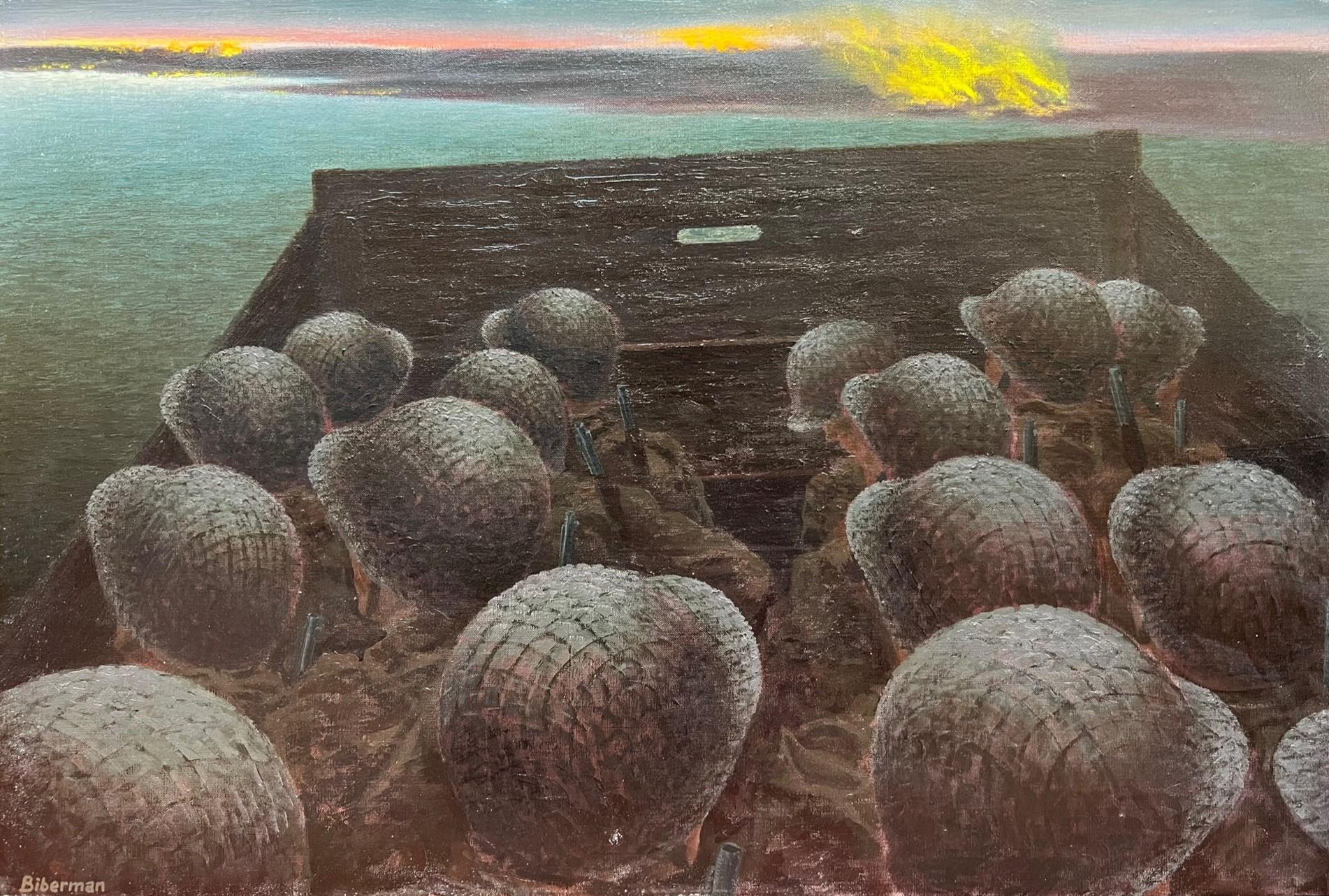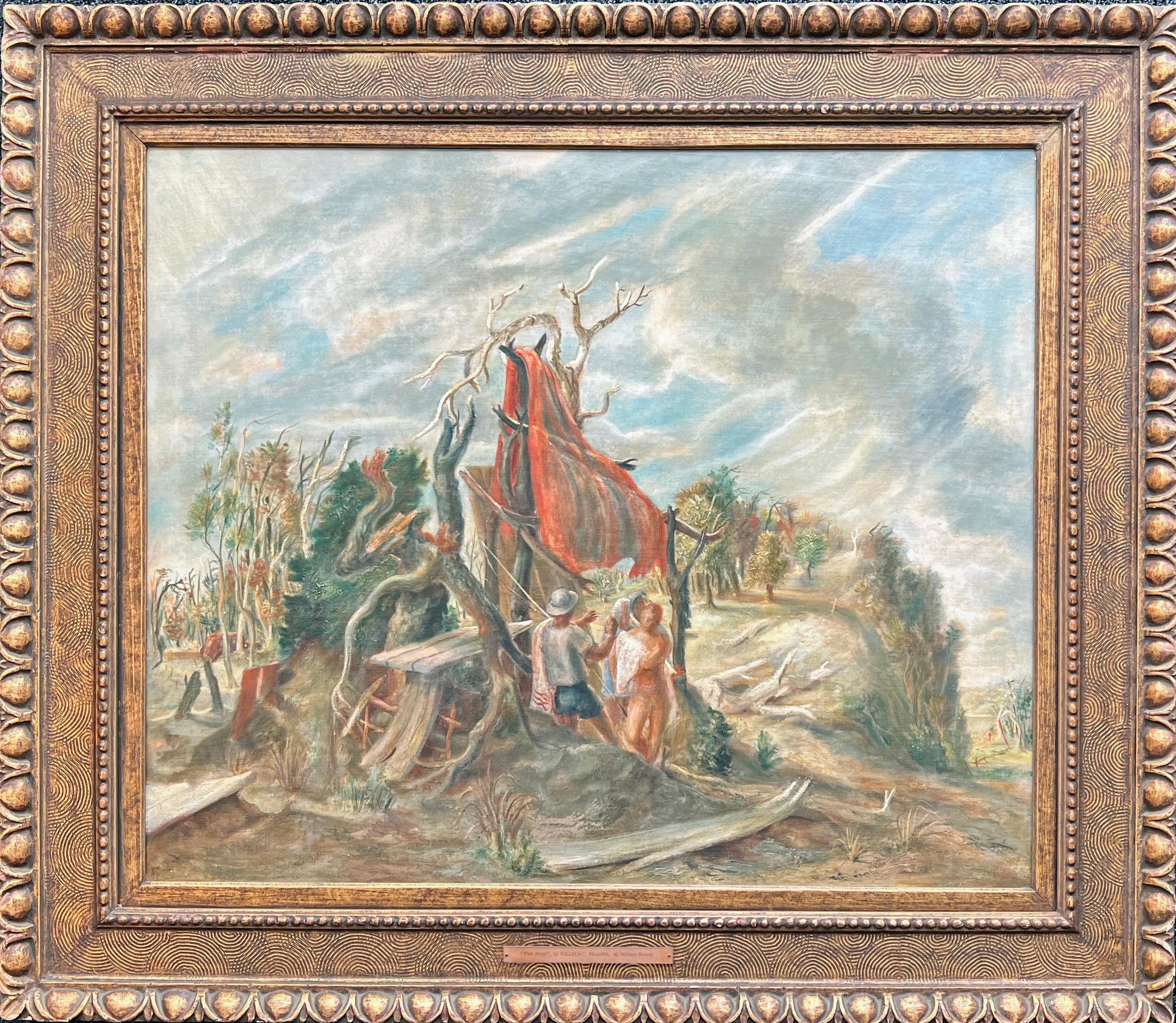Items Similar to 2 Girl Study
Want more images or videos?
Request additional images or videos from the seller
1 of 3
FPA Francis Pavy Artist2 Girl Study 2002
2002
About the Item
This small word depicts two women with different hairstyles. The heads of the women are painted black with a yellow outline and blue spots in the interior. The background
has red triangles with white centers and a block in the middle. The background is gold with green stripes around the triangles.
On the reverse it reads:© Francis Pavy 2002, all rights reserved, #16102, 2 girl study
- Creator:FPA Francis Pavy Artist (1954, American)
- Creation Year:2002
- Dimensions:Height: 9 in (22.86 cm)Width: 3.94 in (10.01 cm)
- Medium:
- Movement & Style:
- Period:
- Condition:
- Gallery Location:Lafayette, LA
- Reference Number:
About the Seller
5.0
Vetted Seller
These experienced sellers undergo a comprehensive evaluation by our team of in-house experts.
Established in 1982
1stDibs seller since 2022
8 sales on 1stDibs
- ShippingRetrieving quote...Ships From: Lafayette, LA
- Return PolicyA return for this item may be initiated within 14 days of delivery.
More From This SellerView All
- Acadian Girl with DiamondsBy FPA Francis Pavy ArtistLocated in Lafayette, LAthe medium for this small painting is oil on Masonite. The painting shows a silhouette of a woman surrounded by diamonds fleur-de-lis's, a guitar and a bottle. on the reverse it reads: ACADIAN GIRL WITH DIAMONDS, © FRANCIS X PAVY...Category
Early 2000s American Modern Figurative Paintings
MaterialsOil
- PENTRIC STUDY #3By FPA Francis Pavy ArtistLocated in Lafayette, LATHIS WORK IS ENTITLED PENTIC STUDY #3 . IT WAS PAINTED AS A STUDY FOR A LARGER COMMISSION THAT NEVER HAPPENED. IN THE TOP LEFT CORNER IS THERE A MARDI GRAS KING. THE CENTRAL FIGURE I...Category
2010s Modern Figurative Paintings
MaterialsOil
- Jimmi's PanchoBy FPA Francis Pavy ArtistLocated in Lafayette, LAThis painting is entitled Jimmi's poncho. It depicts a central figure thinking about other people that appear in the foreground and background. He's wearing a poncho. Signed on the ...Category
1990s Modern Figurative Paintings
MaterialsOil
- Elvis Eagle EyeBy FPA Francis Pavy ArtistLocated in Lafayette, LAHere is an original work on paper by Louisiana Artist Francis X Pavy. the Work is part of an ongoing series about the King of Rock and roll. Elvis Presley. the inspiration for thi...Category
2010s Modern Figurative Paintings
MaterialsOil
- BartenderBy FPA Francis Pavy ArtistLocated in Lafayette, LAThis painting is a picture of a Bartender pouring a drink at a bar. Behind him is a wall of business cards. Signed on the reverse - Writing in in C...Category
1990s Modern Figurative Paintings
MaterialsOil
- People I knowBy FPA Francis Pavy ArtistLocated in Lafayette, LAHere is an original work on paper by Louisiana artist Francis X Pavy. the work depicts imagery of people painted in Layers over Layer. About Francis X Pavy In the vast tapestry ...Category
Early 2000s Modern Figurative Paintings
MaterialsOil
You May Also Like
- Fallen Comrades/InterludeLocated in Los Angeles, CAThis work is part of our exhibition - America Coast to Coast: Artists of the 1940s Fallen Comrades/Interlude, 1949, oil on masonite, signed lower left, 35 x 56 inches; Gallery Z la...Category
1940s American Modern Paintings
MaterialsMasonite, Oil
- Nude with DrapeBy Fletcher MartinLocated in Los Angeles, CANude with Drape, c. 1937, oil on board, 24 x 17 (oval), signed lower right, provenance: Frances Lee Kent Falcone Family Trust About the Painting Fletcher Martin’s Nude with Drape ...Category
1930s American Modern Figurative Paintings
MaterialsOil
- The Landing/Dawn LandingLocated in Los Angeles, CAThis painting is part of our exhibition America Coast to Coast: Artists of the 1940s. The Landing/Dawn Landing, 1944, oil on canvas, signed lower left, 20 x 30, titled verso; exhib...Category
1940s American Modern Paintings
MaterialsCanvas, Oil
- The Magician oil and tempera painting by Julio de DiegoBy Julio de DiegoLocated in Hudson, NYJulio De Diego’s Atomic Series paintings made an extraordinary statement regarding the shock and fear that accompanied the dawn of the nuclear age. In the artist’s own words, “Scientists were working secretly to develop formidable powers taken from the mysterious depths of the earth - with the power to make the earth useless! Then, the EXPLOSION! . . . we entered the Atomic Age, and from there the neo-Atomic war begins. Explosions fell everywhere and man kept on fighting, discovering he could fight without flesh.” To execute these works, De Diego developed a technique of using tempera underpainting before applying layer upon layer of pigmented oil glazes. The result is paintings with surfaces which were described as “bonelike” in quality. The forms seem to float freely, creating a three-dimensional visual effect. In the 1954 book The Modern Renaissance in American Art, author Ralph Pearson summarizes the series as “a fantastic interpretation of a weighty theme. Perhaps it is well to let fantasy and irony appear to lighten the devastating impact. By inverse action, they may in fact increase its weight.” Exhibited 1964 Marion Koogler McNay Art Institute, San Antonio, Texas This work retains its original frame which measures 54" x 42" x 2" About this artist: Julio De Diego crafted a formidable persona within the artistic developments and political struggles of his time. The artist characterized his own work as “lyrical,” explaining, “through the years, the surrealists, the social-conscious painters and the others tried to adopt me, but I went my own way, good, bad or indifferent.” [1] His independence manifested early in life when de Diego left his parent’s home in Madrid, Spain, in adolescence following his father’s attempts to curtail his artistic aspirations. At the age of fifteen he held his first exhibition, set up within a gambling casino. He managed to acquire an apprenticeship in a studio producing scenery for Madrid’s operas, but moved from behind the curtains to the stage, trying his hand at acting and performing as an extra in the Ballet Russes’ Petrouchka with Nijinsky. He spent several years in the Spanish army, including a six-month stretch in the Rif War of 1920 in Northern Africa. His artistic career pushed ahead as he set off for Paris and became familiar with modernism’s forays into abstraction, surrealism, and cubism. The artist arrived in the U.S. in 1924 and settled in Chicago two years later. He established himself with a commission for the decoration of two chapels in St. Gregory’s Church. He also worked in fashion illustration, designed magazine covers and developed a popular laundry bag for the Hotel Sherman. De Diego began exhibiting through the Art Institute of Chicago in 1929, and participated in the annual Chicago Artists Exhibitions, Annual American Exhibitions, and International Water Color Exhibitions. He held a solo exhibition at the Art Institute of Chicago in the summer of 1935. Though the artist’s career was advancing, his family life had deteriorated. In 1932 his first marriage dissolved, and the couple’s young daughter Kiriki was sent to live with friend Paul Hoffman. De Diego continued to develop his artistic vocabulary with a growing interest in Mexican art. He traveled throughout the country acquainting himself with the works of muralists such as Carlos Merida, and also began a collection of small native artifacts...Category
1940s American Modern Abstract Paintings
MaterialsMasonite, Oil, Tempera
- Fish Story oil painting by Williams Charles PalmerLocated in Hudson, NYThis painting is illustrated in the Catalogue of the 1945 Encyclopedia Britannica Collection of Contemporary American Painting, p.84. Written and edited by Grace Pagano. "Painting ...Category
Mid-20th Century American Modern Figurative Paintings
MaterialsOil, Canvas
- St. Atomic oil and tempera painting by Julio de DiegoBy Julio de DiegoLocated in Hudson, NYJulio De Diego’s Atomic Series paintings made an extraordinary statement regarding the shock and fear that accompanied the dawn of the nuclear age. In the artist’s own words, “Scientists were working secretly to develop formidable powers taken from the mysterious depths of the earth - with the power to make the earth useless! Then, the EXPLOSION! . . . we entered the Atomic Age, and from there the neo-Atomic war begins. Explosions fell everywhere and man kept on fighting, discovering he could fight without flesh.” To execute these works, De Diego developed a technique of using tempera underpainting before applying layer upon layer of pigmented oil glazes. The result is paintings with surfaces which were described as “bonelike” in quality. The forms seem to float freely, creating a three-dimensional visual effect. In the 1954 book The Modern Renaissance in American Art, author Ralph Pearson summarizes the series as “a fantastic interpretation of a weighty theme. Perhaps it is well to let fantasy and irony appear to lighten the devastating impact. By inverse action, they may in fact increase its weight.” Exhibited 1950 University of Illinois at Urbana "Contemporary American Painting" 1964 Marion Koogler McNay Art Institute, San Antonio, Texas This work retains its original frame which measures 54" x 36" x 2". About this artist: Julio De Diego crafted a formidable persona within the artistic developments and political struggles of his time. The artist characterized his own work as “lyrical,” explaining, “through the years, the surrealists, the social-conscious painters and the others tried to adopt me, but I went my own way, good, bad or indifferent.” [1] His independence manifested early in life when de Diego left his parent’s home in Madrid, Spain, in adolescence following his father’s attempts to curtail his artistic aspirations. At the age of fifteen he held his first exhibition, set up within a gambling casino. He managed to acquire an apprenticeship in a studio producing scenery for Madrid’s operas, but moved from behind the curtains to the stage, trying his hand at acting and performing as an extra in the Ballet Russes’ Petrouchka with Nijinsky. He spent several years in the Spanish army, including a six-month stretch in the Rif War of 1920 in Northern Africa. His artistic career pushed ahead as he set off for Paris and became familiar with modernism’s forays into abstraction, surrealism, and cubism. The artist arrived in the U.S. in 1924 and settled in Chicago two years later. He established himself with a commission for the decoration of two chapels in St. Gregory’s Church. He also worked in fashion illustration, designed magazine covers and developed a popular laundry bag for the Hotel Sherman. De Diego began exhibiting through the Art Institute of Chicago in 1929, and participated in the annual Chicago Artists Exhibitions, Annual American Exhibitions, and International Water Color Exhibitions. He held a solo exhibition at the Art Institute of Chicago in the summer of 1935. Though the artist’s career was advancing, his family life had deteriorated. In 1932 his first marriage dissolved, and the couple’s young daughter Kiriki was sent to live with friend Paul Hoffman. De Diego continued to develop his artistic vocabulary with a growing interest in Mexican art. He traveled throughout the country acquainting himself with the works of muralists such as Carlos Merida, and also began a collection of small native artifacts...Category
1940s American Modern Abstract Paintings
MaterialsMasonite, Oil, Tempera





